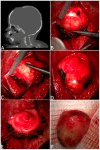Pediatric Cranial Vault Lesions: A Tailored Approach According to Bony Involvement
- PMID: 39594952
- PMCID: PMC11592474
- DOI: 10.3390/children11111377
Pediatric Cranial Vault Lesions: A Tailored Approach According to Bony Involvement
Abstract
Background: Cranial vault lesions are common in children, with dermoid and epidermoid cysts being the most frequent. Management is debated due to their slow growth, but early resection can prevent complications and provide a definitive histological diagnosis, which is sometimes linked to systemic diseases.
Methods: A retrospective study of children treated surgically for cranial vault tumors from January 2011 to April 2023 was conducted. The data collected included age, gender, symptoms, comorbidities, lesion location, radiological features, surgical techniques, histopathology, and recurrence rates.
Results: Eighty-eight children (mean age: 3.5 years, mean tumor size: 1.21 cm) underwent surgery. The most common locations were the frontal and occipital bones. The main diagnoses were dermoid cysts, myofibroma, and Langerhans cell histiocytosis. Gross total resection was achieved in 64 cases with simple skin incisions. In 13 cases, small cranioplasties with bone cement were used. Craniotomy and cranioplasty with autologous bone grafting were performed for 11 patients with lesions larger than 2 cm and full skull thickness erosion.
Conclusions: Early resection is recommended for complete removal with minimally invasive surgery and to ensure histological diagnosis. For lesions larger than 2 cm with full skull erosion, cranioplasty with autologous bone is the preferred technique.
Keywords: Langerhans cell histiocytosis; cranial vault; cranioplasty; dermoid.
Conflict of interest statement
The authors declare no conflicts of interest.
Figures




References
-
- Cummings T.J., George T.M., Fuchs H.E., McLendon R.E. The Pathology of Extracranial Scalp and Skull Masses in Young Children. Clin. Neuropathol. 2004;23:33–43. - PubMed
LinkOut - more resources
Full Text Sources
Miscellaneous

